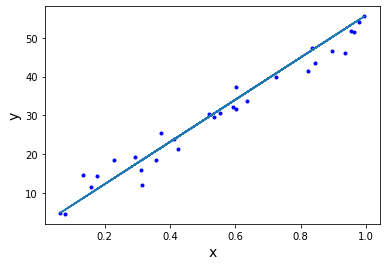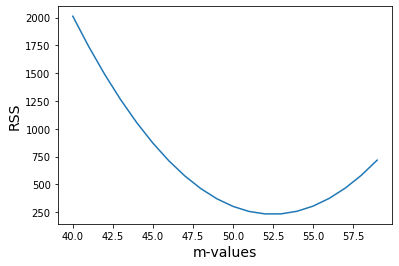It's possible to solve for the optimal values of a regression using closed-form Ordinary Least Squares programming when there are a limited number of features, but this process might become computationally expensive when there are many features. Therefore, iterative algorithms like the gradient descent algorithm are the basis of many models in statistics and machine learning!
You previously saw how after choosing the slope and y-intercept values of a regression line, we can calculate the residual sum of squares (RSS) and related root mean squared error. We can use either the RSS or RMSE to calculate the accuracy of a line. In this lesson, we'll use the RSS to iteratively find the best fit line for our problem at hand!
Once calculating the accuracy of a line, we are pretty close to improving upon a line by minimizing the RSS. This is the task of the gradient descent technique. But before learning about gradient descent, let's review and ensure that we understand how to evaluate how our line fits our data.
You will be able to:
- Describe what gradient descent is, and its relationship to minima
- Describe a cost curve and what it means to move along it
For this example, let's imagine that we have a predictor
- intercept,
$\beta_0$ equal to 3 (which we will refer to as$b$ when estimating it) -
$\beta_1$ equal to 50 (which we will refer to as$m$ when estimating it)
import numpy as np
import matplotlib.pyplot as plt
np.random.seed(225)
x = np.random.rand(30, 1).reshape(30)
y_randterm = np.random.normal(0,3,30)
y = 3+ 50* x + y_randterm
plt.plot(x, y, '.b')
plt.xlabel("x", fontsize=14)
plt.ylabel("y", fontsize=14);Let's again come up with some numbers for a slope and a y-intercept.
One (not so great) technique to get the slope, is by drawing a line between the first and last points. And from there, we calculate the value of
$b$ . You can use thebuild_regression_linefunction, defined in our linear_equations library,linear_equatuions.py, which quickly does this for us.
from linear_equations import build_regression_lineLet's pass build_regression_line function.
build_regression_line(x,y){'int': 1.3188915249780635, 'slope': 54.550106055369}
Turning this into a regression formula, we have the following.
def regression_formula(x):
return 1.319 + 54.550*xLet's plot this regression formula with our data to get a sense of what it looks like.
np.random.seed(225)
x = np.random.rand(30,1).reshape(30)
y_randterm = np.random.normal(0,3,30)
y = 3+ 50* x + y_randterm
plt.plot(x, y, '.b')
plt.plot(x, regression_formula(x), '-')
plt.xlabel("x", fontsize=14)
plt.ylabel("y", fontsize=14);From there, we can calculate the residual sum of squared errors and the root mean squared error.
import math
def errors(x_values, y_values, m, b):
y_line = (b + m*x_values)
return (y_values - y_line)
def squared_errors(x_values, y_values, m, b):
return np.round(errors(x_values, y_values, m, b)**2, 2)
def residual_sum_squares(x_values, y_values, m, b):
return round(sum(squared_errors(x_values, y_values, m, b)), 2)
def root_mean_squared_error(x_values, y_values, m, b):
return round(math.sqrt(sum(squared_errors(x_values, y_values, m, b)))/len(x_values), 2)squared_errors(x, y, 54.550, 1.319 )array([ 4.44, 0.84, 20.68, 14.68, 2.43, 13.23, 10.31, 10.61, 1.2 ,
2.04, 38.08, 5.67, 15.21, 0.43, 2.41, 23.48, 37.39, 4.93,
0.38, 0.7 , 0. , 0. , 5.65, 6.94, 40.66, 0.23, 0.89,
0. , 11.44, 5.04])
residual_sum_squares(x, y, 54.550, 1.319) 279.99
root_mean_squared_error(x, y, 54.550, 1.319) 0.56
We can see that the RSS is equal to 279.99 and the RMSE is 0.56 for our regression line! Do you think we can do better?
Now that we have the residual sum of squares function to evaluate the accuracy of our regression line, we can simply try out different regression lines and use the regression line that has the lowest RSS. The regression line that produces the lowest RSS for a given dataset is called the "best fit" line for that dataset.
So this will be our technique for finding our "best fit" line:
- Choose a regression line with a guess of values for
$m$ and$b$ - Calculate the RSS
- Adjust
$m$ and$b$ , as these are the only things that can vary in a single-variable regression line.- Again calculate the RSS
- Repeat this process
- The regression line (that is, the values of
$b$ and$m$ ) with the smallest RSS is our best fit line
We'll eventually tweak and improve upon that process, but for now, it will do. In fact, we will make things even easier at first by holding
Ok, so we have a regression line of
residual_sum_squares(x, y, 54, 1.319)257.35
We can see that the RSS is already lower here! Now let's the RSS for a variety of
table = np.zeros((20,2))
for idx, val in enumerate(range(40, 60)):
table[idx,0] = val
table[idx,1] = residual_sum_squares(x, y, val, 1.319)tablearray([[ 40. , 2012.31],
[ 41. , 1738.24],
[ 42. , 1487.03],
[ 43. , 1258.71],
[ 44. , 1053.31],
[ 45. , 870.75],
[ 46. , 711.05],
[ 47. , 574.3 ],
[ 48. , 460.37],
[ 49. , 369.35],
[ 50. , 301.17],
[ 51. , 255.89],
[ 52. , 233.49],
[ 53. , 234. ],
[ 54. , 257.35],
[ 55. , 303.64],
[ 56. , 372.74],
[ 57. , 464.75],
[ 58. , 579.66],
[ 59. , 717.43]])
Notice what the above table represents. While keeping our value of
Setting
This changing output of RSS based on a changing input of different regression lines is called our cost function. Let's plot this chart to see it better.
We set:
m_valuesas the input values (x values), andrss_errorsas the output values (y values)
plt.plot(table[:,0], table[:,1], '-')
plt.xlabel("m-values", fontsize=14)
plt.ylabel("RSS", fontsize=14);The graph above is called the cost curve. It is a plot of the RSS for different values of
Note that we end up with a m-value which is not quite the same as
- We used a value for
$b$ which was equal to 1.319, which was quite far from the actual value of 3. Therefore, there is a measurement in error for the slope. - Secondly, randomness was (intentionally) included in our data, so even with the best algorithm, we would come up with a value close to 50, but not exactly 50!
In this section we saw the path from going from calculating the RSS for a given regression line, to finding a line that minimizes our RSS - a best fit line. We learned that we can move to a better regression line by descending along our cost curve. Going forward, we will learn how to move towards our best fit line in an efficient manner.

